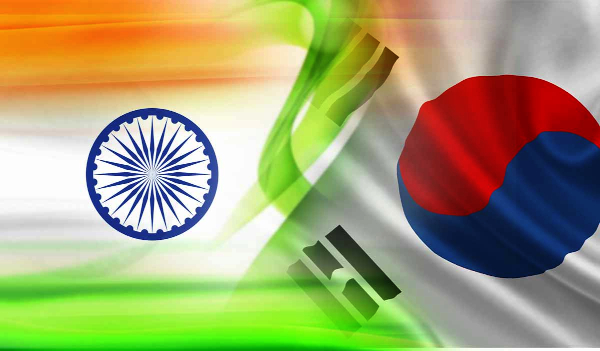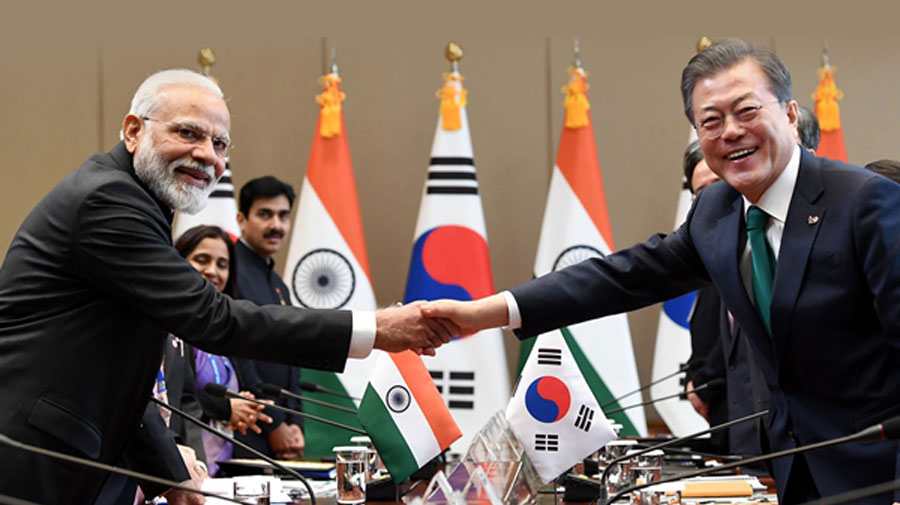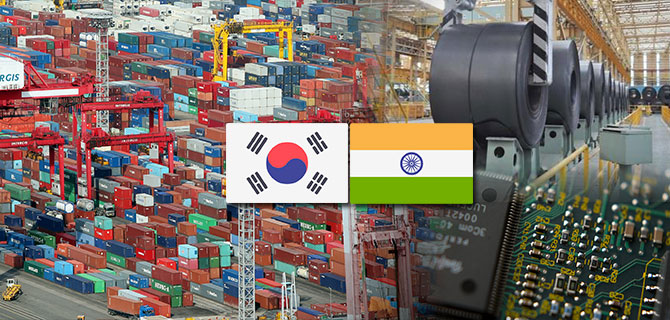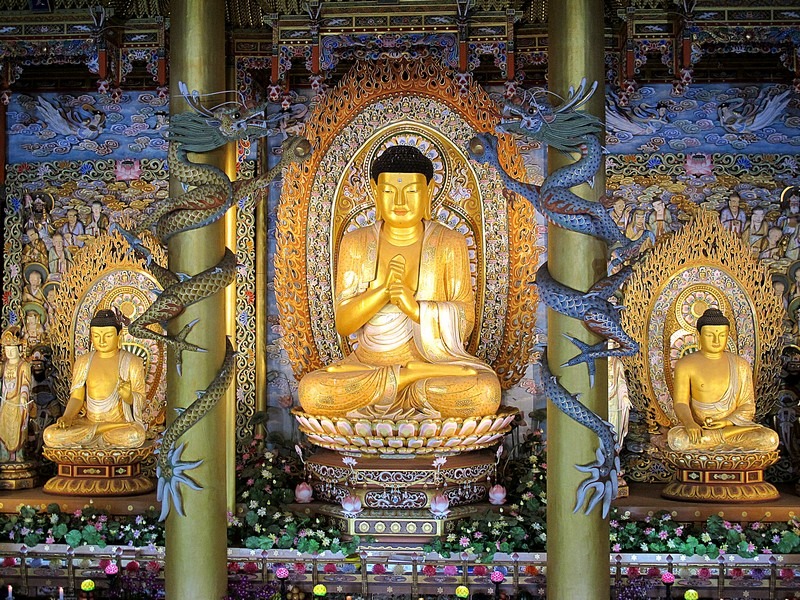
- Relationship between the India and Korea goes beyond the modern constructs of international relations and is part of a legacy of many centuries that transcends present boundaries.
- Malananta, an Indian Buddhist monk brought Buddhism to Baekje in the southern Korean peninsula during the late 4th century. In 526 CE, Korea monk Gyeomik, went to India to learn Sanskrit and study the monastic discipline Vinaya and founded the Gyeyul branch of Buddhism
- India played an important and positive role in Korean affairs after Korea’s independence in 1945. Lt. General K.S. Thimayya, then Chief of Army Staff of India, served as the chairman of the Neutral Nations Repatriation Commission [NNRC], after the armistice and contributed to resolving the humanitarian issues arising out of the War.
- Since 2014, ever since Narendra Modi became the PM, the relationship between India and Korea was elevated to a higher level as part of his Look East Policy (LEP).
- Major Korean conglomerates such as Samsung, Hyundai Motors, and LG have made significant investments into India, estimated at over $4.43 billion (as of March 2017). From the Indian side, investments in ROK is nearing USD 3 billion.
- To defend the region from expansionist forces, India and South Korea, along with other democratic powers in the region, should think of expanding cooperation for alternate economic order and fighting global issues and challenges together.
General MM Naravane, the Chief of the Indian Army is on a three-day visit to the Republic of Korea (ROK) from 28 to 30 December 2020. During the visit, he will be meeting senior military and civilian leadership of the Republic of Korea where he is set to discuss avenues for enhancing India-ROK defence relations.
The relations between the two countries have made great strides in recent years and has become truly multidimensional, especially with the convergence of interests, mutual goodwill and high level exchanges. However, the relationship between the two countries goes beyond the modern constructs of international relations and is part of a legacy of many centuries that transcends present boundaries.
Historical Relations
According to “Samguk Yusa” or “The Heritage History of the Three Kingdoms” written in the 13th century, 3 monks were among the first to bring Buddhist teaching, or Dharma, to Korea. They were Malananta – an Indian Buddhist monk who brought Buddhism to Baekje in the southern Korean peninsula during the late 4th century, Sundo -a Chinese Buddhist monk who brought Buddhism to Goguryeo in northern Korea, and Ado – a Chinese Buddhist monk who brought Buddhism to Silla in central Korea. In Korea, Buddhism was adopted as the state religion of 3 constituent polities of the Three Kingdoms Period, first by the Goguryeo (Gaya) in 372 CE, by the Silla in 528 CE, and by the Baekje in 552 CE.
In 526 CE, Korea monk Gyeomik, went to India to learn Sanskrit and study the monastic discipline Vinaya, and founded the Gyeyul branch of Buddhism that specializes in the study of Vinaya which derives directly from the Indian Vinaya School.

The SamgukYusa also records that a Princess from Ayodhya (Suriratna) came to Korea, married King Kim-Suro, and became Queen Hur Hwang-ok. The wife of former President Lee Myung-bak (Mrs. Kim Yoon-ok), former President Kim Dae-jung, former President Kim Young-sam and former PM Kim Jong-pil, inter alia, trace their ancestry to the royal couple.
Korean Buddhist Monk Hyecho (704–787 CE) or Hong Jiao visited India from 723 to 729 AD and wrote travelogue “Pilgrimage to the five kingdoms of India” which gives a vivid account of Indian culture, politics & society. The travelogue was rediscovered in China in 1908 and was subsequently translated into different languages, including Hindi, under the aegis of UNESCO. The original fragment is now owned by the National Library of France. Nobel Laureate Rabindranath Tagore also composed a short but evocative poem – ‘Lamp of the East’ – in 1929 about Korea’s glorious past and its promising bright future.
Modern Political Relations

India played an important and positive role in Korean affairs after Korea’s independence in 1945. India’s K P S Menon was the Chairman of the 9-member UN Commission set up in 1947 to hold elections in Korea. During the Korean War (1950-53), both the warring sides accepted a resolution sponsored by India, and the ceasefire was declared on 27 July 1953.
Lt. General K.S. Thimayya, then Chief of Army Staff of India, served as the chairman of the Neutral Nations Repatriation Commission [NNRC], after the armistice and contributed to resolving the humanitarian issues arising out of the War, which won appreciation from all quarters. A delegation of Indian Parliamentarians visited ROK on 26-27 July 2013 to participate in the events to commemorate the 60th anniversary of the Armistice Agreement.
The State Visit to RoK by President Dr. APJ Abdul Kalam, in February 2006 heralded a new vibrant phase in India-RoK relations. It led to the launch of a Joint Task Force to conclude a bilateral Comprehensive Economic Partnership Agreement (CEPA), which was operationalized on 1st January 2010. President Lee paid a landmark visit to India, as Chief Guest at India’s Republic Day celebrations on 26 January 2010, when bilateral ties were raised to the level of Strategic Partnership.
Since 2014, ever since Narendra Modi became the PM, the relationship between India and Korea was eleavted to a higher level as part of his Look East Policy (LEP). Prime Minister Narendra Modi paid a state visit to Korea during 18-19 May 2015, taking place within the first year of his government. During the visit the bilateral relationship was upgraded to ‘special strategic partnership’.
The relationship witnessed new momentum following the inauguration of President Moon Jae-in’s administration. PM Modi was one of the first international leaders to congratulate President Moon on his election victory. In addition, PM Modi’s congratulatory tweet in the Korean language was well appreciated by President Moon, Korean media, and common people. President Moon reciprocated by sending Mr. Chung Dongchea, former culture minister, as his special envoy to India, the first such instance in the bilateral relationship, and through a subsequent announcement to upgrade the relationship with India equivalent to four traditional partners under the “New Asia Community Plus” framework.
Growing Trade and Commerce

According to Statistics Korea, Indian exports to Korea accounted for USD 2.91 billion and imports accounts for USD 8.707 billion during January-July 2017, marking a growth of 26% and 30.1% respectively. As mandated by both leaders in 2015, both countries initiated negotiations to upgrade the CEPA to enhance bilateral trade between the two countries.
Major items of India’s exports to Korea are mineral fuels/oil distillates (mainly naphtha), cereals, iron and steel. Basic materials comprise the bulk of India’s exports to Korea with Naphtha accounting 23.9% in 2016. Korea’s main export items are automobile parts, telecommunication equipment, hot rolled iron products, petroleum refined products, base lubricating oils, nuclear reactors, mechanical appliances, electrical machinery & parts and iron and steel products.
Prime Minister’s visit led to a positive focus on India, with shipbuilding, automobile, electronics, textiles, food processing and manufacture being sectors of particular interest. India and South Korea launched an initiative ‘Korea Plus’, as proposed by Prime Minister Modi in June 2016 in India to promote and facilitate Korean Investments in India.
Major Korean conglomerates such as Samsung, Hyundai Motors and LG have made significant investments into India, estimated at over $4.43 billion (as of March 2017). Recently, Kia motors, a sister company of Hyundai Group, announced an investment of USD 1.1 billion to set up a manufacturing unit in Andhra Pradesh and Samsung Electronics announced a USD 760 million investment to expand production facilities in India. In addition, there are 603 large and small Korean firms, which have offices in India.
From the Indian side, investments in ROK is nearing USD 3 billion. Novelis, a Hindalco subsidiary, acquired a Korean aluminium company by investing about $600 million. Mahindra & Mahindra acquired a majority stake in SsangYong Motors, the country’s 4th largest auto manufacturer, in March 2011, with an investment of about $360 million. Tata Motors acquired Daewoo Commercial Vehicle Company for $102 million in March 2004. Other Indian companies present in India include IT majors, Indian Overseas Bank, State Bank of India etc.
Rebooting Cultural Relations

To further enhance cultural exchanges between India and Korea, an Indian Cultural Centre (ICC) was established in Seoul in April 2011. Another Culture Centre was established in Busan in December 2013 on Public Private Partnership mode. A bust of Gurudev Rabindranath Tagore was unveiled in Seoul by the Speaker of the Lok Sabha Smt. Meira Kumar in May 2011.
In order to boost people-to-people relations and travel between the two countries, India extended visa-on-arrival (VoA) facility for Korean tourists from 15 Apr 2014. As a gesture of friendship and goodwill to the Korean people, Prime Minister of India gifted a sapling of the sacred Bodhi Tree under which Lord Buddha had attained enlightenment. A bust of Mahatma Gandhi, presented by ICCR, was unveiled at the Hongbeop-sa temple in Busan on 21 July 2014.
ICC in Seoul and Busan offers regular classes on yoga and dance, both contemporary and classical for promotion of Indian culture. Classes on Hindi, Tabla and cooking have also been started with local teachers as part of outreach activities. Lectures, exhibitions and performances are arranged periodically by ICC. An annual festival of India in Korea titled SARANG was initiated in 2015 and held in 2016, showcasing diverse Indian culture and art forms in various parts of South Korea.
Various institutional arrangements between organisations and entities continue to promote people-to-people exchanges. This includes MoU between FSI and Korea National Diplomatic Academy (KNDA) signed in March 2012, JNU’s MoUs with Yonsei University, Korea University, Hankuk University of Foreign Studies (HUFS) and Busan University of Foreign Studies. DU also has signed an MoU with Korea University. In 2012 Seoul National University established a New Department of Asian Languages and 4 Civilizations wherein they are offering a major on Indian Studies.
Various other Universities in Korea offer degree courses in Indian Philosophy, Yoga and Ayurveda.
Exchange of youth delegations between India and RoK has been taking place on an annual basis for several years now. Government of India offers scholarships and fellowships to Korean nationals for various programmes and disciplines covering research work and non-formal courses every year to study in India. Ayush Scholarship Scheme facilitates courses in Ayurveda, Unani, Siddha, Yoga and Homeopathy, while Hindi language scholarship is being offered by the Kendriya Hindi Sansthan, Agra. RoK Government also offers scholarships to Indian nationals each year to study Korean Language and Literature at Masters and PhD level at select Korean Universities.
The total number of Indian nationals living in ROK is estimated to be around 11,000, which includes 120 PIOs. Around 1,000 Indian scholars are pursuing postgraduate and Ph. D programmes, mostly in pure sciences in Korea. During the past few years, many professionals mainly in the areas of IT, shipping and automobile have immigrated to ROK. They are working mostly with Samsung, LG, Hyundai TATA Daewoo and TCS. There are also significant number of students and academicians in the universities.
Conclusion
The rapid strides made in relations between the two countries in all spheres during the last few years shows that here is massive scope to expand ties between India and South Korea and make it a special relationship in Asia.
Further, the rapid rise of authoritarian regimes particularly China, rising threat of Islamic terrorism, growing trend of protectionism of large democracies especially the US, and a host of other factors have contributed to the rising relevance of non-western democracies. India and Korea, with the possible inclusion of Japan, can fill this space.
To defend the region from expansionist forces, India and South Korea, along with other democratic powers in the region, should think of expanding cooperation for alternate economic order and on fighting global issues and challenges together. They must also build networks of think tanks and research organisations that cater to the previous two requirements.
